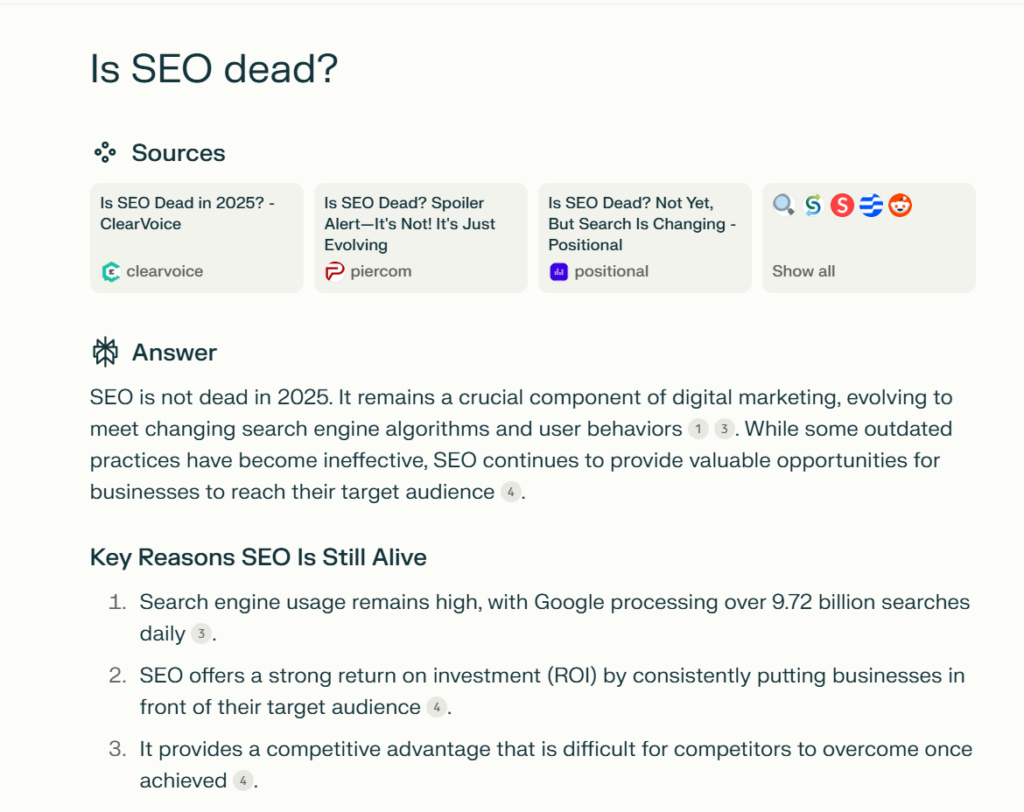What is SAIO? 7 tips to optimize your SEO content for generative AI
What is SAIO? The future of SEO
Is it time to say “SAIO-nara” to traditional SEO as we know it? With the rise of generative AI, search engines and virtual assistants are moving beyond simple keyword matching and rankings. Instead, they’re aiming to deliver fully-formed answers drawn from various sources, leaving traditional SEO strategies scrambling to keep up.
While the term might sound like a distant cousin of “SEO,” SAIO (our Search Artificial Intelligence Optimization) is not exactly business as usual. SEO has already been shifting away from simple keyword-focused tactics, and SAIO takes this evolution further. The goal? To position your content as the authoritative answer for AI-driven tools, search engines, and chatbots. Whether it’s Google’s Search Generative Experience (a.k.a. AI Overviews), ChatGPT, or other AI platforms, the rules of the game have been changing for a while.
Far from being a passing trend, generative AI technologies are marking a turning point in digital marketing. Integrating SAIO into your strategy will improve your visibility and increase your relevance with the latest algorithms. Let’s break it down.
How is Generative AI used in search engines and virtual assistants?
In 2024, Google had placed a bold bet on AI in search with the introduction of AI Overviews—those AI-generated summaries showcased at the top of search results. Tested in 2023 under the Search Generative Experience (SGE), this ambitious project aimed to revolutionize how users interact with information. However, early challenges with accuracy forced Google to scale back its visibility. Initially appearing in 84% of searches, the feature now surfaces in only an estimated 3.9%.
The issues primarily arose in searches involving subjective topics like politics, sensitive areas such as health, and personal opinions from platforms like Quora or Reddit. Despite these hurdles, Google hasn’t abandoned its AI ambitions. Instead, they’ve taken a measured approach, refining the technology and maintaining tighter control over its output.
This isn’t a retreat but a recalibration. With a recent expansion in the countries and languages offered, Google’s continued investment in AI Overviews signals that generative AI remains central to the future of search—albeit with a more deliberate, quality-focused rollout.
This does not mean marketers should pause their efforts to optimize content for AI. Platforms like ChatGPT, Perplexity, or Gemini, with millions of monthly users, have already transformed how we find answers. They don’t just provide a list of options but generate summaries that satisfy all our questions.

Example of an answer in Perplexity’s AI platform, featuring selected sources.
The goal is therefore to make content visible to these AI systems so it becomes an active part of their generated responses. Despite the weight user intent, keywords, backlinks, and meta tags still hold for SEO, SAIO also requires that content is understandable for AI systems and adaptable to multiple formats like text, voice, or images.
Key differences between traditional SEO and SAIO
As we’ve seen, SEO has undergone a radical transformation in recent years. What began with a focus on optimizing pages through specific keywords has evolved into a sophisticated approach centered on understanding and answering user intent.
However, as close as SAIO and SEO might seem, a fine line still separates them. Here’s how SAIO differs from traditional SEO:
| Aspect | Traditional SEO | SAIO |
|---|---|---|
| Visibility impact | Affects traditional search engine rankings, focusing on improving visibility in organic search results. | Influences visibility in AI-generated responses and citations from conversational chatbots and voice assistants. |
| Content approach | Despite its focus on intent, content must still include specific keywords on a certain density level in order for it to rank. | As AI systems use natural language to match user intent, the importance lies more on the meaning and less on the exact expression. |
| Content structure | The best practice is to separate sections using Hn tags (H2, H3…) and separate subtopics into different pages. | Allows to cover the topic and its subtopics on a single page and favors structured (schema markup), longer content such as FAQs, how-tos… |
| Format | SEO is mainly text-focused, although videos and images also hold their weight. | Handles a broader range of inputs, including voice, visual, and conversational queries. |
| Personalization | Content is optimized with a specific audience in mind, but can’t be personalized. | AI provides more tailored results based on user behavior and preferences. |
7 tips to optimize content for SAIO
Optimizing for SAIO takes creativity, knowledge, and the ability to stand out in front of AI algorithms.
1. Make sure AI bots can index your site
To have your content considered by platforms like ChatGPT Search, it’s essential that AI bots can access it. Check your robots.txt file to ensure it doesn’t block key bots like OAI-SearchBot and ChatGPT-User. Allowing them access ensures your content is indexed and potentially used in AI-generated responses.
2. Optimize for Bing
ChatGPT Search combines various search technologies, with Microsoft Bing as its primary search engine. That’s why it’s key to rank well on Bing. Register your site with Bing Webmaster Tools and follow its best practices to boost your visibility.
3. Build trustworthiness
Source reliability is critical for AI-based search engines to consider your content. Cite your sources, and aim to have your articles referenced by reputable media, websites, or social platforms. Regularly updating your content, especially on trending topics, also boosts its relevance.
4. Use structured data and metadata
Implementing structured data like schema markup and rich snippets on your website helps search algorithms understand the context and relevance of your content. This increases the likelihood of being selected by AI models. Reworking meta titles and descriptions can significantly enhance SEO and visibility on generative platforms.
5. Build a strong backlink profile
Getting reputable websites to link to your content signals to AI that your site is trustworthy and authoritative, increasing the chances of being referenced. Analyze your competitors’ backlinks and focus on securing high-quality links that strengthen your site’s authority.
6. Keep content updated
Outdated content rarely appears in results. Regularly refreshing your articles and ensuring they reflect the latest information enhances their relevance and increases the likelihood of being selected by platforms like ChatGPT Search.
7. Expand your online presence
Don’t limit yourself to optimizing your website alone. Boost your presence on directories, social networks, and review sites. Also, invest in media outreach. This improves traditional SEO and increases the chances of your content being used by AI in its responses.
The benefits of SAIO vs. traditional SEO
SAIO offers unique advantages, with visibility being the most significant. AI-generated responses position your content as authoritative, earning user trust and reinforcing your brand’s credibility.
Additionally, SAIO enables content to rank for multiple topics and provides personalized experiences based on user intent. While it doesn’t replace traditional SEO, SAIO complements it, preparing businesses for a new landscape in search increasingly shaped by AI.
Challenges of SAIO
SAIO is not without its challenges. AI algorithms are complex and often opaque, making it hard to predict results. These systems are also susceptible to manipulations like preference attacks, where hidden commands or misleading information influence content prioritization.
At this point in time, it is hard for marketers to do anything about this, and it will likely stay like that for a long time. If Google was never too keen on explaining its algorithms, as we see it ChatGPT, Perplexity and other AI systems are no more likely to do it.
On their side, search engines and virtual assistants are working to reduce manipulations and establish ethical practices to help protect user trust and ensure a healthier digital ecosystem.
At its core, a solid technical and semantic SEO foundation—fast-loading pages, clear architecture, and well-structured content—remains essential for both SEO and SAIO. Standing out in an ocean of information, much of it generated by AI itself is increasingly difficult. The key still lies in producing content that adds tangible value. Infographics, expert analysis, case studies… As we see it, expert-generated content will lead the results in the future, compared to “slop”, generic, low-quality material churned out by generative tools that is likely to see its rankings drop.

